Overview
- Brief Narrative
- British 1 pound note, an emergency wartime issue, acquired by Captain James (Jim) Edward Kirkebo, who served in the US Army from 1940-1945, and fought in Europe with the Thunderbolt Division from December 1944-May 1945. This note was issued to increase security of the currency. The colors were changed and metal security thread in the paper. Kirkebo, 19, enlisted in 1940 and, in August 1942, 2nd Lt. Kirkebo became commanding officer, C Company, 21st Armored Infantry Battalion, 11th Armored Division. In December 1944, Kirkebo's unit landed in Normandy, defended Bastogne during the Battle of the Bulge, and spearheaded the Allied advance into Germany. Kirkebo received a battlefield promotion to captain on February 1, 1945. On May 5 and 6, soldiers from the 11th Armored liberated Gusen and Mauthausen concentration camps. At Mauthausen, the unit was tasked with caring for 19,000 starving inmates. On May 7, 1945, Germany surrendered. Kirkebo was awarded a Silver Star and 3 Bronze Stars for his leadership and heroism in action.
- Date
-
issue:
1940 March 28-1948
- Geography
-
issue:
Great Britain
- Credit Line
- United States Holocaust Memorial Museum Collection, Gift of the Estate of James Edward Kirkebo
- Markings
- face, bottom left and top right, serial number, red ink : D29E 981599
face, center, blue ink : Bank of England / Promise to pay the Bearer / on Demand the sum of / One Pound
face, right, center, white on blue background : 1 / POUND
face, right, bottom, blue ink : LONDON / For the Govr: and Compa: of the / BANK of ENGLAND / K O Peppiatt / Chief Cashier
face, left, bottom, white on blue background : One - Contributor
-
Subject:
James E. Kirkebo
Issuer: Bank of England
Designer: W.M. Keesey
- Biography
-
James (Jim) Edward Kirkebo was born on April 22, 1921, in Tacoma, Washington. He was the second of three children born to Gerhard and Irene Kirkebo. His parents were both born in Norway and immigrated to the United States in the early 1900s. Gerhard was a building contractor. In spring 1939, James graduated from high school and took a job as a shipping clerk.
On September 14, 1940, he enlisted in the US Army. Following the December 7, 1941, attack on Pearl Harbor, the United States entered World War II. James was deployed for four and a half months with the Asia Pacific Technical Operations (APTO) unit, through December 1941. James rose to the rank of Sergeant, with a specialty in reconnaissance. On December 7, Japan attacked Pearl Harbor,a, and a few days later the US entered World War II. On May 11, 1942, James was selected to attend the Army’s newly formed Officer Candidate Course at Fort Benning in Georgia. In early August, Staff Sergeant Kirkebo, 2nd Training Regiment, 16th Co., graduated from the Officer’s Candidate Course and was reenlisted as a Second Lieutenant with a specialty in automotive maintenance and repair. In mid-August, the 11th Armored Division, the Thunderbolt Division, was activated, as part of the Third Army. James was made commanding officer of C Company, 21st Armored Infantry Battalion. The unit was deployed in September to Great Britain. In early December, his unit landed in Normandy, France, and moved north into Belgium. They entered combat on December 30, defending the road to Bastogne during the Battle of the Bulge. In January 1945, the Division spearheaded the Allied advance into Germany. On February 1, James received a field promotion to Captain. In February and March, the 11th Armored overran several cities, then crossed the Rhine River. In April, the unit turned south towards the Danube River and Austria. James was wounded by shrapnel on April 25, but continued fighting. On May 5 and 6, the Division liberated Gusen and Mauthausen concentration camps, two of the largest camps in Austria. The Medical Inspector’s report on Mauthausen stated that "the situation in the camp on the arrival of the US Forces was one of indescribable filth and human degradation." There were over 19,000 prisoners, most little more than skeletons, and over half in need of immediate medical care. They had to keep the inmates from leaving the camp, until they were able to eat again. After starving for so long, they became sick from eating the soldier's rations or regular food. The 11th Armored Division turned to the task of providing medical services, caring for the inmates, and improving conditions in the camp.
On May 7, 1945, Germany surrendered. The Division was placed on occupational duty until August 31, when it was deactivated. On September 1, James was reassigned to the 9th Armored Division, 52nd Armored Infantry Battalion, C Company. The 9th armored continued occupational duties in Germany until early fall. James returned to the US on October 13, 1945, the same day the 9th Armored Division was deactivated. He was relieved from active duty and honorably discharged. James had participated in the Rhineland, Ardennes, and Central Europe Campaigns and received many medals for his service, including a Silver Star, for conspicuous gallantry and intrepidity in leadership while in action against the enemy, Bronze Stars for heroic conduct, Purple Heart, American Defense Service, and campaign medals. James returned to Tacoma and went into business with his father as a building contractor. In the late 1940s, James married Lorna (1920-1998), and the couple had two children. James joined the 6th Army Reserves Company, Instructor Group, transitioning to retired in 1962. James, age 70, died on June 4, 1991, in Tacoma, Washington.
Physical Details
- Language
- English
- Classification
-
Exchange Media
- Category
-
Money
- Object Type
-
Emergency currency (lcsh)
- Physical Description
- Rectangular 1 pound bank note on metal thread security paper with pale blue designs on an orange geometric patterned background. Across the face are 3 medallions: on the left, a seated Britannia with scepter, center, 3 lines of English text above the denomination One, and right, the denomination 1. The serial number in red is on the upper right and lower left. Along the bottom is a narrow rectangle with the denomination One on the left, a white circle with a watermarked image of a helmeted woman, and English text. The reverse has an orange image of the collonaded south front of the Bank of England above 2 orange medallions with St. George on horseback slaying a dragon with a blue background of swirling foliage. The note is creased and stained.
- Dimensions
- overall: Height: 3.250 inches (8.255 cm) | Width: 5.875 inches (14.923 cm)
- Materials
- overall : paper, ink, metal thread
Rights & Restrictions
- Conditions on Access
- No restrictions on access
- Conditions on Use
- No restrictions on use
Keywords & Subjects
Administrative Notes
- Legal Status
- Permanent Collection
- Provenance
- The currency was donated to the United States Holocaust Memorial Museum in 2013 by Jamie Kirkebo, on behalf of the Estate of his father, James Edward Kirkebo.
- Funding Note
- The cataloging of this artifact has been supported by a grant from the Conference on Jewish Material Claims Against Germany.
- Record last modified:
- 2023-08-28 10:31:43
- This page:
- https://collections.ushmm.org/search/catalog/irn84725
Download & Licensing
In-Person Research
- By Appointment
- Request 21 Days in Advance of Visit
- Plan a Research Visit
- Request to See This Object
Contact Us
Also in James Edward Kirkebo collection
The collection consists of artifacts: badges, foreign currency, a jacket, maps, posters, documents, photographs, and publications relating to the experiences of James Edward Kirkebo in the United States Army in Europe during World War II, including the liberation of Gusen and Mauthausen concentration camps.
Date: 1942-1991
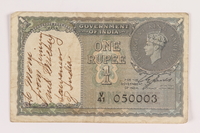
British India, one rupee note, inscribed and acquired by a US soldier
Object
One rupee note issued under the British Raj as an emergency wartime measure in 1940 acquired by James (Jim) Kirkebo. The 1 rupee note had been discontinued in 1934, but paper currency in small denominations was needed as people hoarded metal coins. Kirkebo served in the US Army from 1940-1945, including combat duty in Europe from December 1944-May 1945. Kirkebo, 19, enlisted in 1940 and, in August 1942, 2nd Lt. Kirkebo became commanding officer, C Company, 21st Armored Infantry Battalion, 11th Armored Division. In December 1944, Kirkebo's unit landed in Normandy, defended Bastogne during the Battle of the Bulge, and spearheaded the Allied advance into Germany. Kirkebo received a battlefield promotion to captain on February 1, 1945. On May 5 and 6, soldiers from the 11th Armored liberated Gusen and Mauthausen concentration camps. At Mauthausen, the unit was tasked with caring for 19,000 starving inmates. On May 7, 1945, Germany surrendered. Kirkebo was awarded a Silver Star and 3 Bronze Stars for his leadership and heroism in action.
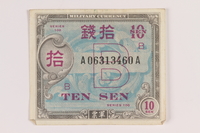
Allied Military Authority currency, 10 sen, B series, for use in Japan, acquired by a US soldier
Object
Allied military currency, 10 sen, issued in postwar occupied Japan, acquired by Captain James (Jim) Edward Kirkebo, who served in the United States Army from 1940-1945, including combat duty with the Thunderbolt Division in Europe from December 1944-May 1945. The B series was issued in Japan from September 1945-July 1948 and in Okinawa until 1958. Military currency or occupation money was produced for use by military personnel in occupied territories. Notes for the different currencies: lire, francs, kroner, marks, schillings, and yen, had similar designs for ease of production. Kirkebo, 19, enlisted in the US Army in 1940 and, in August 1942, 2nd Lt. Kirkebo became commanding officer, C Company, 21st Armored Infantry Battalion, 11th Armored Division. In December 1944, Kirkebo's unit landed in Normandy, defended Bastogne during the Battle of the Bulge, and spearheaded the Allied advance into Germany. Kirkebo received a battlefield promotion to captain on February 1, 1945. On May 5 and 6, soldiers from the 11th Armored liberated Gusen and Mauthausen concentration camps. At Mauthausen, the unit was tasked with caring for 19,000 starving inmates. On May 7, 1945, Germany surrendered. Kirkebo was awarded a Silver Star and 3 Bronze Stars for his leadership and heroism in action.

Allied Military Authority currency, 50 sen, B series, for use in Japan, acquired by a US soldier
Object
Allied military currency, 50 sen, issued in postwar occupied Japan, acquired by Captain James (Jim) Edward Kirkebo, who served in the United States Army from 1940-1945, including combat duty with the Thunderbolt Division in Europe from December 1944-May 1945. The B series was issued in Japan from September 1945-July 1948 and in Okinawa until 1958. Military currency or occupation money was produced for use by military personnel in occupied territories. Notes for the different currencies: lire, francs, kroner, marks, schillings, and yen, had similar designs for ease of production. Kirkebo, 19, enlisted in the US Army in 1940 and, in August 1942, 2nd Lt. Kirkebo became commanding officer, C Company, 21st Armored Infantry Battalion, 11th Armored Division. In December 1944, Kirkebo's unit landed in Normandy, defended Bastogne during the Battle of the Bulge, and spearheaded the Allied advance into Germany. Kirkebo received a battlefield promotion to captain on February 1, 1945. On May 5 and 6, soldiers from the 11th Armored liberated Gusen and Mauthausen concentration camps. At Mauthausen, the unit was tasked with caring for 19,000 starving inmates. On May 7, 1945, Germany surrendered. Kirkebo was awarded a Silver Star and 3 Bronze Stars for his leadership and heroism in action.
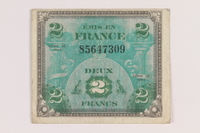
Allied Military Authority currency, 2 francs, for use in France, acquired by a US soldier
Object
Allied military currency, 2 francs, issued for use in occupied France acquired by Captain James (Jim) Kirkebo, who served in the United States Army from 1940-1945, including combat duty with the Thunderbolt Division in Europe from December 1944-May 1945. The note was printed by the British and Americans for the June 1944 D-Day invasion. Military currency or occupation money was produced for use by military personnel in occupied territories. The notes for different currencies: lire, francs, kroner, marks, schillings, and yen, had similar designs for ease of production. Kirkebo, 19, enlisted in the US Army in 1940 and, in August 1942, 2nd Lt. Kirkebo became commanding officer, C Company, 21st Armored Infantry Battalion, 11th Armored Division. In December 1944, Kirkebo's unit landed in Normandy, defended Bastogne during the Battle of the Bulge, and spearheaded the Allied advance into Germany. Kirkebo received a battlefield promotion to captain on February 1, 1945. On May 5 and 6, soldiers from the 11th Armored liberated Gusen and Mauthausen concentration camps. At Mauthausen, the unit was tasked with caring for 19,000 starving inmates. On May 7, 1945, Germany surrendered. Kirkebo was awarded a Silver Star and 3 Bronze Stars for his leadership and heroism in action.
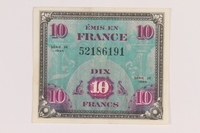
Allied Military Authority currency, 10 francs, for use in France, acquired by a US soldier
Object
Allied military currency, 10 francs, issued for use in occupied France acquired by Captain James (Jim) Kirkebo, who served in the United States Army from 1940-1945, including combat duty with the Thunderbolt Division in Europe from December 1944-May 1945. The note was printed by the British and Americans for the June 1944 D-Day invasion. Military currency or occupation money was produced for use by military personnel in occupied territories. The notes for different currencies: lire, francs, kroner, marks, schillings, and yen, had similar designs for ease of production. Kirkebo, 19, enlisted in the US Army in 1940 and, in August 1942, 2nd Lt. Kirkebo became commanding officer, C Company, 21st Armored Infantry Battalion, 11th Armored Division. In December 1944, Kirkebo's unit landed in Normandy, defended Bastogne during the Battle of the Bulge, and spearheaded the Allied advance into Germany. Kirkebo received a battlefield promotion to captain on February 1, 1945. On May 5 and 6, soldiers from the 11th Armored liberated Gusen and Mauthausen concentration camps. At Mauthausen, the unit was tasked with caring for 19,000 starving inmates. On May 7, 1945, Germany surrendered. Kirkebo was awarded a Silver Star and 3 Bronze Stars for his leadership and heroism in action.
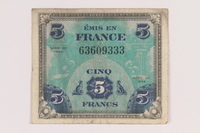
Allied Military Authority currency, 5 francs, for use in France, acquired by a US soldier
Object
Allied military currency, 5 francs, issued for use in occupied France acquired by Captain James (Jim) Kirkebo, who served in the United States Army from 1940-1945, including combat duty with the Thunderbolt Division in Europe from December 1944-May 1945. The note was printed by the British and Americans for the June 1944 D-Day invasion. Military currency or occupation money was produced for use by military personnel in occupied territories. The notes for different currencies: lire, francs, kroner, marks, schillings, and yen, had similar designs for ease of production. Kirkebo, 19, enlisted in the US Army in 1940 and, in August 1942, 2nd Lt. Kirkebo became commanding officer, C Company, 21st Armored Infantry Battalion, 11th Armored Division. In December 1944, Kirkebo's unit landed in Normandy, defended Bastogne during the Battle of the Bulge, and spearheaded the Allied advance into Germany. Kirkebo received a battlefield promotion to captain on February 1, 1945. On May 5 and 6, soldiers from the 11th Armored liberated Gusen and Mauthausen concentration camps. At Mauthausen, the unit was tasked with caring for 19,000 starving inmates. On May 7, 1945, Germany surrendered. Kirkebo was awarded a Silver Star and 3 Bronze Stars for his leadership and heroism in action.
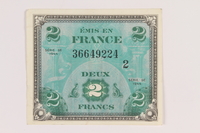
Allied Military Authority currency, 2 francs, for use in France, acquired by a US soldier
Object
Allied military currency, 2 francs, issued for use in occupied France acquired by Captain James (Jim) Kirkebo, who served in the United States Army from 1940-1945, including combat duty with the Thunderbolt Division in Europe from December 1944-May 1945. The note was printed by the British and Americans for the June 1944 D-Day invasion. Military currency or occupation money was produced for use by military personnel in occupied territories. The notes for different currencies: lire, francs, kroner, marks, schillings, and yen, had similar designs for ease of production. Kirkebo, age 19, enlisted in the Army in September 1940. In August 1942, 2nd Lieutenant Kirkebo became commanding officer of C Company, 21st Armored Infantry Battalion, 11th Armored Division, Third Army. In December 1944, Kirkebo's unit landed in Normandy, and defended Bastogne during the Battle of the Bulge. The 11th Armored spearheaded the Allied advance into Germany and pushed through to Austria. Kirkebo received a battlefield promotion to captain on February 1, 1945. On May 5 and 6, soldiers from the 11th Armored liberated Gusen and Mauthausen concentration camps. At Mauthausen, they discovered over 19,000 starving inmates. The unit was tasked with caring for the inmates and improving camp conditions. On May 7, 1945, Germany surrendered. Kirkebo was on occupational duty until October when he returned to the US. Kirkebo was awarded a Silver Star and Bronze Star for his bravery in action.
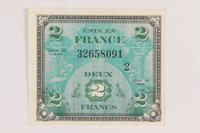
Allied Military Authority currency, 2 francs, for use in France, acquired by a US soldier
Object
Allied military currency, 2 francs, issued for use in occupied France acquired by Captain James (Jim) Kirkebo, who served in the United States Army from 1940-1945, including combat duty with the Thunderbolt Division in Europe from December 1944-May 1945. The note was printed by the British and Americans for the June 1944 D-Day invasion. Military currency or occupation money was produced for use by military personnel in occupied territories. The notes for different currencies: lire, francs, kroner, marks, schillings, and yen, had similar designs for ease of production. Kirkebo, 19, enlisted in the US Army in 1940 and, in August 1942, 2nd Lt. Kirkebo became commanding officer, C Company, 21st Armored Infantry Battalion, 11th Armored Division. In December 1944, Kirkebo's unit landed in Normandy, defended Bastogne during the Battle of the Bulge, and spearheaded the Allied advance into Germany. Kirkebo received a battlefield promotion to captain on February 1, 1945. On May 5 and 6, soldiers from the 11th Armored liberated Gusen and Mauthausen concentration camps. At Mauthausen, the unit was tasked with caring for 19,000 starving inmates. On May 7, 1945, Germany surrendered. Kirkebo was awarded a Silver Star and 3 Bronze Stars for his leadership and heroism in action.
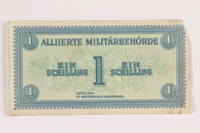
Allied Military Authority currency, 1 schilling, for use in Austria, acquired by a US soldier
Object
Allied military currency, 1 schilling, issued for use by Allied troops in occupied Austria, acquired by Captain James (Jim) Kirkebo, who served in the United States Army from 1940-1945, including combat duty with the Thunderbolt Division in Europe from December 1944-May 1945. Military currency or occupation money was produced for use by military personnel in occupied territories. Kirkebo, 19, enlisted in the US Army in 1940 and, in August 1942, 2nd Lt. Kirkebo became commanding officer, C Company, 21st Armored Infantry Battalion, 11th Armored Division. In December 1944, Kirkebo's unit landed in Normandy, defended Bastogne during the Battle of the Bulge, and spearheaded the Allied advance into Germany. Kirkebo received a battlefield promotion to captain on February 1, 1945. On May 5 and 6, soldiers from the 11th Armored liberated Gusen and Mauthausen concentration camps. At Mauthausen, the unit was tasked with caring for 19,000 starving inmates. On May 7, 1945, Germany surrendered. Kirkebo was awarded a Silver Star and 3 Bronze Stars for his leadership and heroism in action.
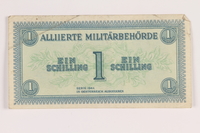
Allied Military Authority currency, 1 schilling, for use in Austria, acquired by a US soldier
Object
Allied military currency, 1 schilling, issued for use by Allied troops in occupied Austria, acquired by Captain James (Jim) Kirkebo, who served in the United States Army from 1940-1945, including combat duty with the Thunderbolt Division in Europe from December 1944-May 1945. Military currency or occupation money was produced for use by military personnel in occupied territories. Kirkebo, age 19, enlisted in the Army in September 1940. In August 1942, 2nd Lieutenant Kirkebo became commanding officer of C Company, 21st Armored Infantry Battalion, 11th Armored Division, Third Army. In December 1944, Kirkebo's unit landed in Normandy, and defended Bastogne during the Battle of the Bulge. The 11th Armored spearheaded the Allied advance into Germany and pushed through to Austria. Kirkebo received a battlefield promotion to captain on February 1, 1945. On May 5 and 6, soldiers from the 11th Armored liberated Gusen and Mauthausen concentration camps. At Mauthausen, they discovered over 19,000 starving inmates. The unit was tasked with caring for the inmates and improving camp conditions. On May 7, 1945, Germany surrendered. Kirkebo he returned to the US. Kirkebo was awarded a Silver Star and Bronze Star for his bravery in action.
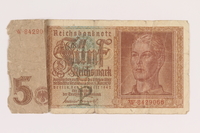
Nazi Germany, 5 mark note, acquired by a US soldier
Object
Five mark German bank note acquired by Captain James (Jim) Kirkebo who served with the US Army from 1940-45, and in combat with the Thunderbolt Division in Europe from December 1944-May 1945. Kirkebo, 19, enlisted in the US Army in 1940 and, in August 1942, 2nd Lt. Kirkebo became commanding officer, C Company, 21st Armored Infantry Battalion, 11th Armored Division. In December 1944, Kirkebo's unit landed in Normandy, defended Bastogne during the Battle of the Bulge, and spearheaded the Allied advance into Germany. Kirkebo received a battlefield promotion to captain on February 1, 1945. On May 5 and 6, soldiers from the 11th Armored liberated Gusen and Mauthausen concentration camps. At Mauthausen, the unit was tasked with caring for 19,000 starving inmates. On May 7, 1945, Germany surrendered. Kirkebo was awarded a Silver Star and 3 Bronze Stars for his leadership and heroism in action.
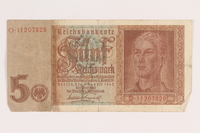
Nazi Germany, 5 mark note, acquired by a US soldier
Object
Five mark German bank note acquired by Captain James (Jim) Kirkebo who served with the US Army from 1940-45, and in combat with the Thunderbolt Division in Europe from December 1944-May 1945. Kirkebo, age 19, enlisted in the US Army in September 1940. In August 1942, 2nd Lieutenant Kirkebo became commanding officer of C Company, 21st Armored Infantry Battalion, 11th Armored Division, Third Army. In December 1944, Kirkebo's unit landed in Normandy, and defended Bastogne during the Battle of the Bulge. The 11th Armored spearheaded the Allied advance into Germany and pushed through to Austria. Kirkebo received a battlefield promotion to captain on February 1, 1945. On May 5 and 6, soldiers from the 11th Armored liberated Gusen and Mauthausen concentration camps. At Mauthausen, they discovered over 19,000 starving inmates. The unit was tasked with caring for the inmates and improving camp conditions. On May 7, 1945, Germany surrendered. Kirkebo was on occupational duty until October when he returned to the US. Kirkebo was awarded a Silver Star and 3 Bronze Stars for his Kirkebo was on occupational duty until early October when he returned to the US. Kirkebo was awarded a Silver Star and 3 Bronze Stars for his heroism and leadership in action.
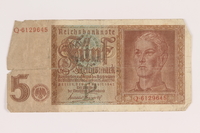
Nazi Germany, 5 mark note, acquired by a US soldier
Object
Five mark German bank note acquired by Captain James Edward Kirkebo, who served in the US Army from 1940-1945, and fought in Europe from December 1944-May 1945. Kirkebo, age 19, enlisted in the Army in September 1940. In August 1942, 2nd Lieutenant Kirkebo became commanding officer, C Company, 21st Armored Infantry Battalion, 11th Armored Division. In early December 1944, Kirkebo's unit landed in Normandy, and defended Bastogne during the Battle of the Bulge. The 11th Armored spearheaded the Allied advance into Germany and pushed through to Austria. Kirkebo received a battlefield promotion to captain on February 1, 1945. On May 5 and 6, soldiers from the 11th Armored Division liberated Gusen and Mauthausen concentration camps. At Mauthausen, they discovered over 19,000 starving inmates, many in need of immediate medical care. The unit was tasked with caring for the inmates and improving camp conditions. On May 7, 1945, Germany surrendered. Kirkebo was on occupational duty until early October when he returned to the US. Kirkebo was awarded a Silver Star and Bronze Star for his heroism and leadership in action.
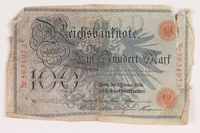
Imperial Germany Reichsbanknote, 100 mark, acquired by a US soldier
Object
100 mark German bank note, 1908 issue, acquired by Captain James Edward Kirkebo, who served in the US Army from 1940-1945, and fought in Europe with the Thunderbolt Division from December 1944-May 1945. Kirkebo, 19, enlisted in the US Army in 1940 and, in August 1942, 2nd Lt. Kirkebo became commanding officer, C Company, 21st Armored Infantry Battalion, 11th Armored Division. In December 1944, Kirkebo's unit landed in Normandy, defended Bastogne during the Battle of the Bulge, and spearheaded the Allied advance into Germany. Kirkebo received a battlefield promotion to captain on February 1, 1945. On May 5 and 6, soldiers from the 11th Armored liberated Gusen and Mauthausen concentration camps. At Mauthausen, the unit was tasked with caring for 19,000 starving inmates. On May 7, 1945, Germany surrendered. Kirkebo was awarded a Silver Star and 3 Bronze Stars for his leadership and heroism in action.
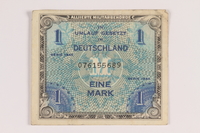
Allied Military Authority currency, 1 mark, for use in Germany, acquired by a US soldier
Object
Allied military currency, 1 [eine] mark, issued for use by Allied troops in occupied Germany acquired by Captain James Edward Kirkebo, who served in the US Army from 1940-1945, and fought in Europe with the Thunderbolt Division from December 1944-May 1945. Kirkebo, 19, enlisted in the US Army in 1940 and, in August 1942, 2nd Lt. Kirkebo became commanding officer, C Company, 21st Armored Infantry Battalion, 11th Armored Division. In December 1944, Kirkebo's unit landed in Normandy, defended Bastogne during the Battle of the Bulge, and spearheaded the Allied advance into Germany. Kirkebo received a battlefield promotion to captain on February 1, 1945. On May 5 and 6, soldiers from the 11th Armored liberated Gusen and Mauthausen concentration camps. At Mauthausen, the unit was tasked with caring for 19,000 starving inmates. On May 7, 1945, Germany surrendered. Kirkebo was awarded a Silver Star and 3 Bronze Stars for his leadership and heroism in action.
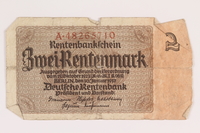
Nazi Germany, 2 Rentenmark note acquired by a US soldier
Object
Two [zwei] rentenmark German note acquired by Captain James Edward Kirkebo, who served in the US Army from 1940-1945, and fought in Europe with the Thunderbolt Division from December 1944-May 1945. It was first issued by the Weimar government as emergency currency during the runaway inflation of the 1920s, but was reissued and remained in circulation until 1945. Kirkebo, 19, enlisted in the US Army in 1940 and, in August 1942, 2nd Lt. Kirkebo became commanding officer, C Company, 21st Armored Infantry Battalion, 11th Armored Division. In December 1944, Kirkebo's unit landed in Normandy, defended Bastogne during the Battle of the Bulge, and spearheaded the Allied advance into Germany. Kirkebo received a battlefield promotion to captain on February 1, 1945. On May 5 and 6, soldiers from the 11th Armored liberated Gusen and Mauthausen concentration camps. At Mauthausen, the unit was tasked with caring for 19,000 starving inmates. On May 7, 1945, Germany surrendered. Kirkebo was awarded a Silver Star and 3 Bronze Stars for his leadership and heroism in action.
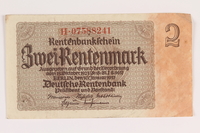
Nazi Germany, 2 Rentenmark note acquired by a US soldier
Object
Two [zwei] rentenmark note issued in Nazi Germany acquired by Captain James Edward Kirkebo, who served in the US Army from 1940-1945, and fought in Europe with the Thunderbolt Division from December 1944-May 1945. It was first issued by the Weimar government as emergency currency during the runaway inflation of the 1920s, but was reissued and remained in circulation until 1945. Kirkebo, 19, enlisted in the US Army in 1940 and, in August 1942, 2nd Lt. Kirkebo became commanding officer, C Company, 21st Armored Infantry Battalion, 11th Armored Division. In December 1944, Kirkebo's unit landed in Normandy, defended Bastogne during the Battle of the Bulge, and spearheaded the Allied advance into Germany. Kirkebo received a battlefield promotion to captain on February 1, 1945. On May 5 and 6, soldiers from the 11th Armored liberated Gusen and Mauthausen concentration camps. At Mauthausen, the unit was tasked with caring for 19,000 starving inmates. On May 7, 1945, Germany surrendered. Kirkebo was awarded a Silver Star and 3 Bronze Stars for his leadership and heroism in action.
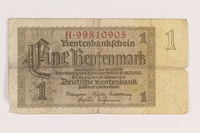
Nazi Germany, 1 Rentenmark note acquired by a US soldier
Object
One rentenmark German note acquired by Captain James Edward Kirkebo, who served in the US Army from 1940-1945, and fought in Europe with the Thunderbolt Division from December 1944-May 1945. It was first issued by the Weimar government as emergency currency during the runaway inflation of the 1920s, but was reissued and remained in circulation until 1945. Kirkebo, age 19, enlisted in the Army in September 1940. In August 1942, 2nd Lieutenant Kirkebo became commanding officer, C Company, 21st Armored Infantry Battalion, 11th Armored Division. In December 1944, Kirkebo's unit landed in Normandy, and defended Bastogne during the Battle of the Bulge. The 11th Armored spearheaded the Allied advance into Germany and pushed through to Austria. Kirkebo received a battlefield promotion to captain on February 1, 1945. On May 5 and 6, soldiers from the 11th Armored liberated Gusen and Mauthausen concentration camps. At Mauthausen, they discovered over 19,000 starving inmates. The unit was tasked with caring for the inmates and improving camp conditions. On May 7, 1945, Germany surrendered. Kirkebo was on occupational duty until October when he returned to the US. Kirkebo was awarded a Silver Star and Bronze Star for his bravery in action.
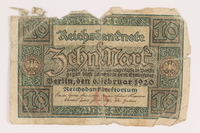
Weimar Germany, 10 mark note acquired by a US soldier
Object
Ten mark bank note of Weimar Germany acquired by Captain James Edward Kirkebo, who served in the US Army from 1940-1945, and fought in Europe with the Thunderbolt Division from December 1944-May 1945. Kirkebo, age 19, enlisted in the Army in September 1940. In August 1942, 2nd Lieutenant Kirkebo became commanding officer, C Company, 21st Armored Infantry Battalion, 11th Armored Division. In December 1944, Kirkebo's unit landed in Normandy, and defended Bastogne during the Battle of the Bulge. The 11th Armored spearheaded the Allied advance into Germany and pushed through to Austria. Kirkebo received a battlefield promotion to captain on February 1, 1945. On May 5 and 6, soldiers from the 11th Armored liberated Gusen and Mauthausen concentration camps. At Mauthausen, they discovered over 19,000 starving inmates. The unit was tasked with caring for the inmates and improving camp conditions. On May 7, 1945, Germany surrendered. Kirkebo was on occupational duty until October when he returned to the US.
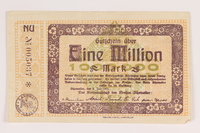
Ahrweiler District, Weimar Germany, 1 million mark note, acquired by a US soldier
Object
One million mark note issued in Ahrweiler District in Germany as emergency currency during the runaway inflation of the 1920s acquired by Captain James Edward Kirkebo, who served in the US Army from 1940-1945, and fought in Europe with the Thunderbolt Division from December 1944-May 1945. Kirkebo, age 19, enlisted in September 1940. In August 1942, 2nd Lieutenant Kirkebo became commanding officer, C Company, 21st Armored Infantry Battalion, 11th Armored Division, Third Army. In December 1944, Kirkebo's unit landed in Normandy, and defended Bastogne during the Battle of the Bulge. The 11th Armored spearheaded the Allied advance into Germany and pushed through to Austria. Kirkebo received a battlefield promotion to captain on February 1, 1945. On May 5 and 6, soldiers from the 11th Armored liberated Gusen and Mauthausen concentration camps. At Mauthausen, they discovered over 19,000 starving inmates. The unit was tasked with caring for the inmates and improving camp conditions. On May 7, 1945, Germany surrendered. Kirkebo was on occupational duty until October when he returned to the Star for his bravery in action.
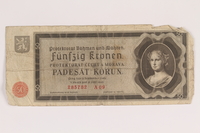
Germany, occupation currency, 50 crowns, issued in the Protectorate of Bohemia and Moravia acquired by a US soldier
Object
Fifty crown note, issued in the Protectorate of Bohemia and Moravia of German occupied Czechoslovakia acquired by Captain James (Jim) Edward Kirkebo, who served in the US Army from 1940-1945, and fought in Europe with the Thunderbolt Division from December 1944-May 1945. Kirkebo, age 19, enlisted in September 1940. In August 1942, 2nd Lieutenant Kirkebo became commanding officer of C Company, 21st Armored Infantry Battalion, 11th Armored Division, Third Army. In December 1944, Kirkebo's unit landed in Normandy and defended Bastogne during the Battle of the Bulge. The 11th Armored spearheaded the Allied advance into Germany and pushed through to Austria. Kirkebo received a field promotion to captain on February 1, 1945. On May 5 and 6, soldiers from the 11th Armored liberated Gusen and Mauthausen concentration camps. At Mauthausen, they discovered over 19,000 starving inmates. The unit was tasked with caring for the inmates and improving camp conditions. On May 7, 1945, Germany surrendered. Kirkebo was on occupational duty until October when he returned to the US. Kirkebo was awarded a Silver Star and Bronze Star for his heroism and leadership in action.
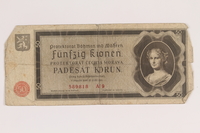
Germany, occupation currency, 50 crowns, issued in the Protectorate of Bohemia and Moravia acquired by a US soldier
Object
Fifty crown note, issued in the Protectorate of Bohemia and Moravia of German occupied Czechoslovakia acquired by Captain James Edward Kirkebo, who served in the US Army from 1940-1945, and fought in Europe with the Thunderbolt Division from December 1944-May 1945. Kirkebo, 19, enlisted in the US Army in 1940 and, in August 1942, 2nd Lt. Kirkebo became commanding officer, C Company, 21st Armored Infantry Battalion, 11th Armored Division. In December 1944, Kirkebo's unit landed in Normandy, defended Bastogne during the Battle of the Bulge, and spearheaded the Allied advance into Germany. Kirkebo received a battlefield promotion to captain on February 1, 1945. On May 5 and 6, soldiers from the 11th Armored liberated Gusen and Mauthausen concentration camps. At Mauthausen, the unit was tasked with caring for 19,000 starving inmates. On May 7, 1945, Germany surrendered. Kirkebo was awarded a Silver Star and 3 Bronze Stars for his leadership and heroism in action.
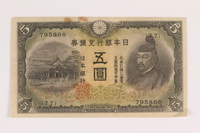
Imperial Japan, 5 yen note, issued in occupied China acquired by a US soldier
Object
Japanese 5 yen note acquired by Captain James (Jim) Edward Kirkebo, who served in the US Army from 1940-1945, and fought in Europe with the Thunderbolt Division from December 1944-May 1945. This type of currency was issued by the Bank of Japan but then used as a military banknote as Japan expanded their occupation of China in 1938. This note does not have the military seals. Kirkebo, 19, enlisted in the US Army in 1940 and, in August 1942, 2nd Lt. Kirkebo became commanding officer, C Company, 21st Armored Infantry Battalion, 11th Armored Division. In December 1944, Kirkebo's unit landed in Normandy, defended Bastogne during the Battle of the Bulge, and spearheaded the Allied advance into Germany. Kirkebo received a battlefield promotion to captain on February 1, 1945. On May 5 and 6, soldiers from the 11th Armored liberated Gusen and Mauthausen concentration camps. At Mauthausen, the unit was tasked with caring for 19,000 starving inmates. On May 7, 1945, Germany surrendered. Kirkebo was awarded a Silver Star and 3 Bronze Stars for his leadership and heroism in action.
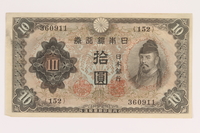
Imperial Japan, 10 yen note, issued for use in occupied China acquired by a US soldier
Object
Japanese 10 yen note acquired by Captain James (Jim) Edward Kirkebo,who served in the US Army from 1940-1945, and fought in Europe with the Thunderbolt Division from December 1944-May 1945. This currency was first issued in 1930 by the Bank of Japan but then used, with variants, as a military banknote as Japan expanded their occupation of China in 1938. This variant has 2 red seals on the front. Kirkebo, 19, enlisted in the US Army in 1940 and, in August 1942, 2nd Lt. Kirkebo became commanding officer, C Company, 21st Armored Infantry Battalion, 11th Armored Division. In December 1944, Kirkebo's unit landed in Normandy, defended Bastogne during the Battle of the Bulge, and spearheaded the Allied advance into Germany. Kirkebo received a battlefield promotion to captain on February 1, 1945. On May 5 and 6, soldiers from the 11th Armored liberated Gusen and Mauthausen concentration camps. At Mauthausen, the unit was tasked with caring for 19,000 starving inmates. On May 7, 1945, Germany surrendered. Kirkebo was awarded a Silver Star and 3 Bronze Stars for his leadership and heroism in action.
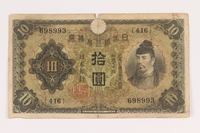
Imperial Japan, 10 yen note, acquired by a US soldier
Object
Japanese 10 yen note acquired by Captain James (Jim) Edward Kirkebo. This currency was first issued in 1930, and reissued without the English text in 1944. Kirkebo served in the US Army from 1940-1945, and fought in Europe with the Thunderbolt Division from December 1944-May 1945. Kirkebo, 19, enlisted in 1940 and, in August 1942, 2nd Lt. Kirkebo became commanding officer, C Company, 21st Armored Infantry Battalion, 11th Armored Division. In December 1944, Kirkebo's unit landed in Normandy, defended Bastogne during the Battle of the Bulge, and spearheaded the Allied advance into Germany. Kirkebo received a battlefield promotion to captain on February 1, 1945. On May 5 and 6, soldiers from the 11th Armored liberated Gusen and Mauthausen concentration camps. At Mauthausen, the unit was tasked with caring for 19,000 starving inmates. On May 7, 1945, Germany surrendered. Kirkebo was awarded a Silver Star and 3 Bronze Stars for his leadership and heroism in action.
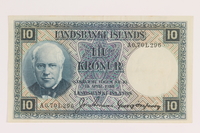
Iceland, 10 kronur, acquired by a US soldier
Object
Icelandic 10 kronur note acquired by Captain James (Jim) Edward Kirkebo, who served in the US Army from 1940-1945, and fought in Europe with the Thunderbolt Division from December 1944-May 1945. Kirkebo, 19, enlisted in the US Army in 1940 and, in August 1942, 2nd Lt. Kirkebo became commanding officer, C Company, 21st Armored Infantry Battalion, 11th Armored Division. In December 1944, Kirkebo's unit landed in Normandy, defended Bastogne during the Battle of the Bulge, and spearheaded the Allied advance into Germany. Kirkebo received a battlefield promotion to captain on February 1, 1945. On May 5 and 6, soldiers from the 11th Armored liberated Gusen and Mauthausen concentration camps. At Mauthausen, the unit was tasked with caring for 19,000 starving inmates. On May 7, 1945, Germany surrendered. Kirkebo was awarded a Silver Star and 3 Bronze Stars for his leadership and heroism in action.
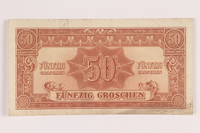
Allied Military Authority, 50 groschen, for use in Austria acquired by a US soldier
Object
Allied military currency, 50 groschen, issued for use by Allied troops in occupied Austria, acquired by Captain James (Jim) Kirkebo, who served in the United States Army from 1940-1945, including combat duty with the Thunderbolt Division in Europe from December 1944-May 1945. Military currency or occupation money was produced for use by military personnel in occupied territories. Kirkebo, 19, enlisted in the US Army in 1940 and, in August 1942, 2nd Lt. Kirkebo became commanding officer, C Company, 21st Armored Infantry Battalion, 11th Armored Division. In December 1944, Kirkebo's unit landed in Normandy, defended Bastogne during the Battle of the Bulge, and spearheaded the Allied advance into Germany. Kirkebo received a battlefield promotion to captain on February 1, 1945. On May 5 and 6, soldiers from the 11th Armored liberated Gusen and Mauthausen concentration camps. At Mauthausen, the unit was tasked with caring for 19,000 starving inmates. On May 7, 1945, Germany surrendered. Kirkebo was awarded a Silver Star and 3 Bronze Stars for his leadership and heroism in action.
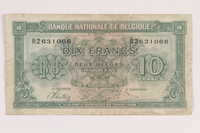
Belgium, 10 francs or 2 belga note, acquired by a US soldier
Object
Belgian 10 franc or 2 belga note, a liberation issue by the Belgian government in exile acquired by Captain James (Jim) Edward Kirkebo, who served in the US Army from 1940-1945, and fought in Europe with the Thunderbolt Division from December 1944-May 1945. It was prepared for use by Allied troops in London where the Belgian government fled in October 1940 after the German invasion of Belgium that May. All currency was dated February 1, 1943. It was recalled in 1946 but redeemable until 1947. Kirkebo, 19, enlisted in the US Army in 1940 and, in August 1942, 2nd Lt. Kirkebo became commanding officer, C Company, 21st Armored Infantry Battalion, 11th Armored Division. In December 1944, Kirkebo's unit landed in Normandy, defended Bastogne during the Battle of the Bulge, and spearheaded the Allied advance into Germany. Kirkebo received a battlefield promotion to captain on February 1, 1945. On May 5 and 6, soldiers from the 11th Armored liberated Gusen and Mauthausen concentration camps. At Mauthausen, the unit was tasked with caring for 19,000 starving inmates. On May 7, 1945, Germany surrendered. Kirkebo was awarded a Silver Star and 3 Bronze Stars for his leadership and heroism in action.
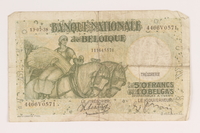
Belgium, 50 francs or 10 belga note, acquired by a US soldier
Object
Belgian 50 franc or 10 belga note, with 1 Belga equallng 5 Belgian francs, acquired by Captain James (Jim) Edward Kirkebo, who served in the US Army from 1940-1945, and fought in Europe with the Thunderbolt Division from December 1944-May 1945. Kirkebo, 19, enlisted in 1940 and, in August 1942, 2nd Lt. Kirkebo became commanding officer, C Company, 21st Armored Infantry Battalion, 11th Armored Division. In December 1944, Kirkebo's unit landed in Normandy, defended Bastogne during the Battle of the Bulge, and spearheaded the Allied advance into Germany. Kirkebo received a battlefield promotion to captain on February 1, 1945. On May 5 and 6, soldiers from the 11th Armored liberated Gusen and Mauthausen concentration camps. At Mauthausen, the unit was tasked with caring for 19,000 starving inmates. On May 7, 1945, Germany surrendered. Kirkebo was awarded a Silver Star and 3 Bronze Stars for his leadership and heroism in action.
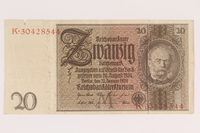
Weimar Germany, 20 mark note, acquired by a US soldier
Object
Twenty [zwanzig] mark German bank note acquired by Captain James (Jim) Edward Kirkebo, who served in the US Army from 1940-1945, and fought in Europe with the Thunderbolt Division from December 1944-May 1945. Kirkebo, 19, enlisted in the US Army in 1940 and, in August 1942, 2nd Lt. Kirkebo became commanding officer, C Company, 21st Armored Infantry Battalion, 11th Armored Division. In December 1944, Kirkebo's unit landed in Normandy, defended Bastogne during the Battle of the Bulge, and spearheaded the Allied advance into Germany. Kirkebo received a battlefield promotion to captain on February 1, 1945. On May 5 and 6, soldiers from the 11th Armored liberated Gusen and Mauthausen concentration camps. At Mauthausen, the unit was tasked with caring for 19,000 starving inmates. On May 7, 1945, Germany surrendered. Kirkebo was awarded a Silver Star and 3 Bronze Stars for his leadership and heroism in action.
James Edward Kirkebo papers
Document
Collection consists of photographs of the liberation of Mauthausen and scenes in France; original negatives, documents, clippings, and pamphlets related to the 11th Armored Division during WWII.
Infantry tank officer’s field jacket with several ribbon bars and pins worn by a US soldier
Object
Infantry tank officer’s field jacket with 3 ribbon bars and several pins worn by Captain James Edward Kirkebo, who served in the US Army from 1940-1945, and fought in Europe from December 1944-May 1945. A 1943 study by the Quartermaster Corps found that dress uniform coats were impractical in combat. Eisenhower recommended the short British battle jacket as the basis for a new design, and it became known as an Eisenhower jacket. Kirkebo, 19, enlisted in the US Army in 1940 and, in August 1942, 2nd Lt. Kirkebo became commanding officer, C Company, 21st Armored Infantry Battalion, 11th Armored Division. In December 1944, Kirkebo's unit landed in Normandy, defended Bastogne during the Battle of the Bulge, and spearheaded the Allied advance into Germany. Kirkebo received a battlefield promotion to captain on February 1, 1945. On May 5 and 6, soldiers from the 11th Armored liberated Gusen and Mauthausen concentration camps. At Mauthausen, the unit was tasked with caring for 19,000 starving inmates. On May 7, 1945, Germany surrendered. Kirkebo was awarded a Silver Star and 3 Bronze Stars for his leadership and heroism in action.
US Combat Infantryman Badge in silver bullion awarded to a US soldier
Object
US Combat Infantryman Badge issued to Captain James (Jim) Edward Kirkebo, who served in the US Army from 1940-1945, and fought in Europe in from December 1944-May 1945. The badge has a model of a 1795 Springfield Arsenal musket, the first official US shoulder arm, on an infantry blue field, over an oak leaf wreath, symbolizing strength and loyalty. It is awarded for performing duties while under fire in active ground combat. Kirkebo, 19, enlisted in the US Army in 1940 and, in August 1942, 2nd Lt. Kirkebo became commanding officer, C Company, 21st Armored Infantry Battalion, 11th Armored Division. In December 1944, Kirkebo's unit landed in Normandy, defended Bastogne during the Battle of the Bulge, and spearheaded the Allied advance into Germany. Kirkebo received a battlefield promotion to captain on February 1, 1945. On May 5 and 6, soldiers from the 11th Armored liberated Gusen and Mauthausen concentration camps. At Mauthausen, the unit was tasked with caring for 19,000 starving inmates. On May 7, 1945, Germany surrendered. Kirkebo was awarded a Silver Star and 3 Bronze Stars for his leadership and heroism in action.
US Army 11th Armored Division shoulder sleeve insignia patch issued to a soldier
Object
Shoulder sleeve insignia, 11th Armored Division, the Thunderbolt Division, issued to Captain James Edward Kirkebo, who served in the US Army from 1940-1945, and fought in Europe from December 1944-May 1945. The patch colors represent the military branches that form an armored division: yellow for cavalry, blue for infantry, and red for artillery. The symbols are for characteristics: tank track, mobility and armor protection; cannon, fire power; red flash of lightning, shock action. Kirkebo, 19, enlisted in the US Army in 1940 and, in August 1942, 2nd Lt. Kirkebo became commanding officer, C Company, 21st Armored Infantry Battalion, 11th Armored Division. In December 1944, Kirkebo's unit landed in Normandy, defended Bastogne during the Battle of the Bulge, and spearheaded the Allied advance into Germany. Kirkebo received a battlefield promotion to captain on February 1, 1945. On May 5 and 6, soldiers from the 11th Armored liberated Gusen and Mauthausen concentration camps. At Mauthausen, the unit was tasked with caring for 19,000 starving inmates. On May 7, 1945, Germany surrendered. Kirkebo was awarded a Silver Star and 3 Bronze Stars for his leadership and heroism in action.
US Army 9th Armored Division shoulder sleeve insignia patch issued to a soldier
Object
Shoulder sleeve insignia, 9th Armored Division, issued to Captain James Edward Kirkebo, who served in the US Army from 1940-1945, and fought in Europe from December 1944-May 1945. The patch colors represent the military branches that form an armored division: yellow for cavalry, blue for infantry, and red for artillery. The symbols represent characteristics: tank track, mobility and armor protection; cannon, fire power; red flash of lightning, shock action. Kirkebo, age 19, enlisted in the US Army on September 14, 1940. In August 1942, 2nd Lieutenant Kirkebo became commanding officer, C Company, 21st Armored Infantry Battalion, 11th Armored Division, Third Army. In December 1944, Kirkebo's unit landed in Normandy, and defended Bastogne during the Battle of the Bulge. The 11th Armored spearheaded the Allied advance into Germany and pushed through to Austria. Kirkebo received a battlefield promotion to captain on February 1, 1945. On May 5 and 6, soldiers from the 11th Armored liberated Gusen and Mauthausen concentration camps. At Mauthausen, they discovered over 19,000 starving inmates. The unit was tasked with caring for the inmates and improving camp conditions. On May 7, 1945, Germany surrendered. Kirkebo was on occupational duty until early October when he returned to the US. Kirkebo was awarded a Silver Star and 3 Bronze Stars for his heroism and leadership in action.
US Army 9th Armored Division shoulder sleeve insignia patch issued to a soldier
Object
Shoulder sleeve insignia, 9th Armored Division, issued to Captain James Edward Kirkebo, who served in the US Army from 1940-1945, and fought in Europe from December 1944-May 1945. The patch colors represent the military branches that form an armored division: yellow for cavalry, blue for infantry, and red for artillery. The symbols represent characteristics: tank track, mobility and armor protection; cannon, fire power; red flash of lightning, shock action. Kirkebo, age 19, enlisted in the US Army on September 14, 1940. In August 1942, 2nd Lieutenant Kirkebo became commanding officer, C Company, 21st Armored Infantry Battalion, 11th Armored Division, Third Army. In December 1944, Kirkebo's unit landed in Normandy, and defended Bastogne during the Battle of the Bulge. The 11th Armored spearheaded the Allied advance into Germany and pushed through to Austria. Kirkebo received a battlefield promotion to captain on February 1, 1945. On May 5 and 6, soldiers from the 11th Armored liberated Gusen and Mauthausen concentration camps. At Mauthausen, they discovered over 19,000 starving inmates. The unit was tasked with caring for the inmates and improving camp conditions. On May 7, 1945, Germany surrendered. Kirkebo was on occupational duty until early October when he returned to the US. Kirkebo was awarded a Silver Star and 3 Bronze Stars for his heroism and leadership in action.
US Army 9th Armored Division shoulder sleeve insignia patch issued to a soldier
Object
Shoulder sleeve insignia, 9th Armored Division, issued to Captain James Edward Kirkebo, who served in the US Army from 1940-1945, and fought in Europe from December 1944-May 1945. The patch colors represent the military branches that form an armored division: yellow for cavalry, blue for infantry, and red for artillery. The symbols represent characteristics: tank track, mobility and armor protection; cannon, fire power; red flash of lightning, shock action. Kirkebo, age 19, enlisted in the US Army on September 14, 1940. In August 1942, 2nd Lieutenant Kirkebo became commanding officer, C Company, 21st Armored Infantry Battalion, 11th Armored Division, Third Army. In December 1944, Kirkebo's unit landed in Normandy, and defended Bastogne during the Battle of the Bulge. The 11th Armored spearheaded the Allied advance into Germany and pushed through to Austria. Kirkebo received a battlefield promotion to captain on February 1, 1945. On May 5 and 6, soldiers from the 11th Armored liberated Gusen and Mauthausen concentration camps. At Mauthausen, they discovered over 19,000 starving inmates. The unit was tasked with caring for the inmates and improving camp conditions. On May 7, 1945, Germany surrendered. Kirkebo was on occupational duty until early October when he returned to the US. Kirkebo was awarded a Silver Star and 3 Bronze Stars for his heroism and leadership in action.
Small poster issued to US troops to discourage socializing with Germans received by a US soldier
Object
Don't Fraternize Mauthausen handbill received by 24 year old Captain James (Jim) Kirkebo while serving in the US Army, 11th Armored Division, in Germany in May 1945. The US Army issued poster uses an image of piled rows of inmate corpses discovered at Mauthausen concentration camp to remind soldiers not to fraternize with German civilians. The camp was liberated by Kirkebo's Division, the 11th Armored, on May 6, 1945. Kirkebo, age 19, enlisted in the US Army in September 1940. In August 1942, 2nd Lieutenant Kirkebo became commanding officer of C Company, 21st Armored Infantry Battalion, 11th Armored Division, Third Army. In December 1944, Kirkebo's unit landed in Normandy, and defended Bastogne during the Battle of the Bulge. The 11th Armored spearheaded the Allied advance into Germany and pushed through to Austria. Kirkebo received a battlefield promotion to captain on February 1, 1945. On May 5 and 6, soldiers from the 11th Armored liberated Gusen and Mauthausen concentration camps. At Mauthausen, they discovered over 19,000 starving inmates. The unit was tasked with caring for the inmates and improving camp conditions. On May 7, 1945, Germany surrendered. Kirkebo was on occupational duty until October when he returned to the US. Kirkebo was awarded a Silver Star and 3 Bronze Stars for his heroism and leadership in action.
11th Armored Division double sided poster of news reports received by a soldier
Object
11th Armored division The Press Says... poster collage of news reports received by 24 year old Captain James (Jim) Kirkebo in June 1945 while serving in the US Army, 11th Armored Division, in Germany. Kirkebo, age 19, enlisted in the US Army in September 1940. In August 1942, 2nd Lieutenant Kirkebo became commanding officer of C Company, 21st Armored Infantry Battalion, 11th Armored Division, Third Army. In December 1944, Kirkebo's unit landed in Normandy, and defended Bastogne during the Battle of the Bulge. The 11th Armored spearheaded the Allied advance into Germany and pushed through to Austria. Kirkebo received a battlefield promotion to captain on February 1, 1945. On May 5 and 6, soldiers from the 11th Armored liberated Gusen and Mauthausen concentration camps. At Mauthausen, they discovered over 19,000 starving inmates. The unit was tasked with caring for the inmates and improving camp conditions. On May 7, 1945, Germany surrendered. Kirkebo was on occupational duty until October when he returned to the US. Kirkebo was awarded a Silver Star and 3 Bronze Stars for his heroism and leadership in action.
Two-sided 11th Armored Division, US Army, after action poster of battle events received by a soldier
Object
Double sided 11th Armored after action report poster received by 24 year old Captain James (Jim) Kirkebo in May 1945 while serving with the Thunderbolt Division in Germany. Kirkebo, age 19, enlisted in the US Army in September 1940. In August 1942, 2nd Lieutenant Kirkebo became commanding officer of C Company, 21st Armored Infantry Battalion, 11th Armored Division, Third Army. In December 1944, Kirkebo's unit landed in Normandy, and defended Bastogne during the Battle of the Bulge. The 11th Armored spearheaded the Allied advance into Germany and pushed through to Austria. Kirkebo received a battlefield promotion to captain on February 1, 1945. On May 5 and 6, soldiers from the 11th Armored liberated Gusen and Mauthausen concentration camps. At Mauthausen, they discovered over 19,000 starving inmates. The unit was tasked with caring for the inmates and improving camp conditions. On May 7, 1945, Germany surrendered. Kirkebo was on occupational duty until October when he returned to the US. Kirkebo was awarded a Silver Star and 3 Bronze Stars for his Kirkebo was on occupational duty until early October when he returned to the US. Kirkebo was awarded a Silver Star and 3 Bronze Stars for his heroism and leadership in action.
Two-sided Company B, 11th Armored Division, US Army, poster depicting the advance through Europe received by a soldier
Object
Double sided foldable poster with a map on one side and illustrations on the other received by 24 year old Captain James (Jim) Kirkebo circa June 1945 while serving in the US Army, 11th Armored Division, in Germany. Kirkebo, 19, enlisted in the US Army in 1940 and, in August 1942, 2nd Lt. Kirkebo became commanding officer, C Company, 21st Armored Infantry Battalion, 11th Armored Division. In December 1944, Kirkebo's unit landed in Normandy, defended Bastogne during the Battle of the Bulge, and spearheaded the Allied advance into Germany. Kirkebo received a battlefield promotion to captain on February 1, 1945. On May 5 and 6, soldiers from the 11th Armored liberated Gusen and Mauthausen concentration camps. At Mauthausen, the unit was tasked with caring for 19,000 starving inmates. On May 7, 1945, Germany surrendered. Kirkebo was awarded a Silver Star and 3 Bronze Stars for his leadership and heroism in action.
Two-sided Company B, 11th Armored Division, US Army, poster depicting the advance through Europe received by a soldier
Object
Double sided foldable poster with a map on one side and illustrations on the other received by 24 year old Captain James (Jim) Kirkebo circa June 1945 while serving in the US Army, 11th Armored Division, in Germany. Kirkebo, 19, enlisted in the US Army in 1940 and, in August 1942, 2nd Lt. Kirkebo became commanding officer, C Company, 21st Armored Infantry Battalion, 11th Armored Division. In December 1944, Kirkebo's unit landed in Normandy, defended Bastogne during the Battle of the Bulge, and spearheaded the Allied advance into Germany. Kirkebo received a battlefield promotion to captain on February 1, 1945. On May 5 and 6, soldiers from the 11th Armored liberated Gusen and Mauthausen concentration camps. At Mauthausen, the unit was tasked with caring for 19,000 starving inmates. On May 7, 1945, Germany surrendered. Kirkebo was awarded a Silver Star and 3 Bronze Stars for his leadership and heroism in action.
Name tag
Object
Infantry tank officer’s name tag found in the field jacket with 3 ribbon bars and several pins worn by Captain James Edward Kirkebo, who served in the US Army from 1940-1945, and fought in Europe from December 1944-May 1945. A 1943 study by the Quartermaster Corps found that dress uniform coats were impractical in combat. Eisenhower recommended the short British battle jacket as the basis for a new design, and it became known as an Eisenhower jacket. Kirkebo, 19, enlisted in the US Army in 1940 and, in August 1942, 2nd Lt. Kirkebo became commanding officer, C Company, 21st Armored Infantry Battalion, 11th Armored Division. In December 1944, Kirkebo's unit landed in Normandy, defended Bastogne during the Battle of the Bulge, and spearheaded the Allied advance into Germany. Kirkebo received a battlefield promotion to captain on February 1, 1945. On May 5 and 6, soldiers from the 11th Armored liberated Gusen and Mauthausen concentration camps. At Mauthausen, the unit was tasked with caring for 19,000 starving inmates. On May 7, 1945, Germany surrendered. Kirkebo was awarded a Silver Star and 3 Bronze Stars for his leadership and heroism in action.



